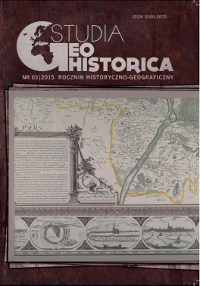Pamięć krajobrazu – zapis dziejów w przestrzeni
Landscape Memory – the Record of History in Space
Author(s): Urszula Myga-PiątekSubject(s): Human Geography, Historical Geography, Maps / Cartography
Published by: Polskie Towarzystwo Historyczne
Keywords: krajobraz kulturowy;pamięć krajobrazu;stratygrafia krajobrazu;geografia;cultural landscape;landscape memory;stratigraphy of landscape;geography
Summary/Abstract: Landscape currently takes a particularly important place in many scientific disciplines, for example in geography, cultural anthropology, aesthetics, architecture, landscape architecture, landscape ecology and sociology. The reason for the great interest in landscape is that it is synonymous to everyday existence, the surroundings and the human environment. The article draws attention to the fact that contemporary landscape seems to be a key issue in understanding the historical processes occurring in the human environment. The concept of landscape is therefore a kind of “link” between geography and history. Nowadays the literature of the sources says about “the idea of landscape,” which expresses the historical effort to connect the visual image and the material world. The following considerations are attempts to develop a concept which describes the memory of landscape on the basis of geography. It is an attempt at a complementary approach to the existing studies in the field of humanistic geography, cultural anthropology, sociology and the theory of aesthetics. The article presents the genesis of the concept, giving the source of its ambiguity. In geography landscape commonly means the following: – a set of spatially related physical objects (both natural and anthropogenic) constituting the content of the landscape; – a system of interrelated natural and cultural processes integrating the physical structures; – a set of stimuli affecting the various senses of the user; – a set of natural values (potentials), social, economic, physical, spiritual, historical, physiognomy, aesthetic, symbolic and others; – a system providing the actual and potential service (now called landscape services or so-called landscape functions); – text, symbol, icon, palimpsest, or even a metaphor. In the broadest sense, memory is the ability to remember, store, recall, recognize and localize something that happened in the past. In the case of transfer of this concept onto the field of landscape, it is like the identity of the countryside, the memory does not mean forms of space personalization, but it expresses a special ability to record, store and recall the information about the phenomena and processes taking place in the history and taking place in the social and geographical environment. It is also the process of collecting spatial information. Regarding the landscape, this ability depends on many factors. It may take the shortterm form (memory of history record about events, short duration story) but usually, the landscape is a storehouse of information and traces of theoretically unlimited capacity and storage. The author proposes to separate a few types of landscape memory: – material memory, which is physical storage of objects and their inter-systems (spatial structures) as a form of static, real being. “Saved” and fixed objects in the landscape are not only the relics of ancient times, monuments, but they also clearly organize the space. The material form of “landscape memory” is expressed mainly by the presence of “hibernating” spatial systems (villages, towns, urban structure, texture and copper fields, road systems, etc.) with origins in ancient times, often surrounded by sites from a later period (from another era); – axiological memory, understood as storage of value. It is based on continuity, among others, tradition, identity, familiarity relating to both, tangible and intangible qualities of landscape; – phenomenological memory, which means storing information about phenomena (events, incidents, including extreme ones in terms of natural and cultural ones); – magnificence of space is located here, which is registered in landscape biography. It is mostly short-term memory, episodic, written in the history of long duration; – ontological memory, interpreted in the context of storing information about the nature of the landscape, its properties, causality (factors and stimuli), properties. It is the story of landscape recognized as a dynamic phenomenon, in which the rights and principles of landscape creation are saved; – semantic memory, which means storage of fixed meanings (symbolic landscapes, semiotics of space, storage of genius loci, the sacrum). Th e possibility which is given by “re-reading” the former and modern functions of landscape. The paper explains the above-mentioned forms of landscape memory on the grounds of the author’s concept of cultural landscape stratigraphy. The basic types of landscapes were separated due to the relative arrangement (ascertainable in chronological order) of cultural strata present in the landscape, as a product of particular communities functioning in the history of the area.
Journal: Studia Geohistorica
- Issue Year: 2015
- Issue No: 3
- Page Range: 29-45
- Page Count: 16
- Language: Polish

